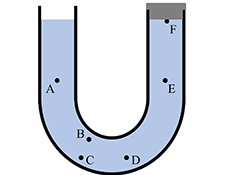
Pressure
Variant i Interactive tutorial lecture Other Variants Dynamics first
Students apply Newton's laws to examine how pressure varies within an incompressible fluid.
Topics Fluid mechanics / Hydrostatics: systems, atmospheric pressure, fluids, forces, free-body diagrams, Newton's second and third laws, and pressure
Materials
Materials by the UW team
- Clicker Questions Only


- Instructor Guide


- Pretest



- Pretest for LMS



- Exam Questions



- Equipment List

Tutorial details
Section I: Applying Newton’s laws to fluids
Students draw free-body diagrams for two equal volumes of water separated by an imaginary, horizontal boundary in a container. They use Newton’s laws and the fact that the layers are at rest to rank the magnitudes of all the vertical forces on the systems.
Section II: Pressure and force
Questions A-C guide students to use their force ranking and the definition of pressure to rank the pressure at different locations within the water. Students then demonstrate that this ranking is consistent with the equation for pressure as a function of depth. Included is a short derivation of this equation.
In Question D, students consider a dialogue about the pressure at different points within an L-shaped container of water. Questions E & F lead students to recognize that the pressure at equal depths within the fluid is the same regardless of what is above a particular point in the water. Then students rank the pressure at five different locations in the L-shaped container.
Section III: Pressure in a U-tube
Students rank the pressure at different points within a U-shaped tube, then consider the effect of sealing one end of the tube with a stopper. Students then analyze the situation where water is removed from the other end of the tube so that the water levels on each side are no longer the same.
For instruction tips, login or register as a verified educator to see the Instructor Guide.
Prerequisites
Prerequisite tutorials
The Newton's second and third laws tutorial is a prerequisite to Pressure.
Other prerequisites
Students should have experience drawing free-body diagrams and applying Newton’s second and third laws, as well as knowledge of the relationship between pressure and force.
Equipment
Special Instructions
If, after the interactive tutorial lecture, students need access to the video showing the result of the experiment in this tutorial, they can find it at this link: https://youtu.be/LKCFBdPcxt8.
List
- tutorial instructor slides
- tutorial student slides or worksheet
Research
- M. E. Loverude, P. R. L. Heron, and C. H. Kautz, Identifying and addressing student difficulties with hydrostatic pressure, 78 (1) 75-85 (2009).
Coming Soon! We hope to release the discussion section on each tutorial soon.

